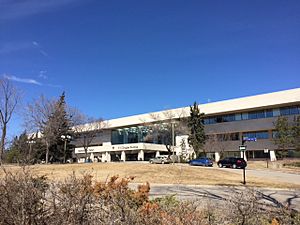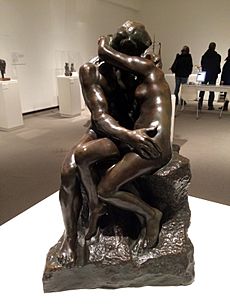MacKenzie Art Gallery facts for kids

Exterior facade of the MacKenzie Art Gallery
|
|
| Former name | Norman Mackenzie Art Gallery |
|---|---|
| Established | 1953 |
| Location | 3475 Albert Street, Regina, Saskatchewan, Canada |
| Type | Art museum |
The MacKenzie Art Gallery (MAG) is a cool art museum in Regina, Saskatchewan, Canada. It's a place where you can see amazing artworks! The museum is inside a big building called the T. C. Douglas Building, right next to the beautiful Wascana Centre. This building has eight large rooms, called galleries, where art is shown. These galleries together have about 2,230 square meters (24,000 square feet) of space for exhibits.
The museum started with a special collection of art given by a person named Norman MacKenzie. He donated his private collection to Regina College (which later became the University of Regina). In 1953, the college created the Norman MacKenzie Art Gallery to show off these artworks. Later, in 1990, the art museum became its own independent place, separate from the university. That's when it moved into its current home, the T. C. Douglas Building.
The MacKenzie Art Gallery has a huge permanent collection with over 5,000 artworks. These pieces cover more than 5,000 years of Canadian history and art from around the world. Besides showing its own collection, the museum also hosts many travelling art shows. This means you can see different art from other places too!
Contents
Discovering the MacKenzie Art Gallery's History
The MacKenzie Art Gallery began with the art collection of Norman MacKenzie. He gave his collection to Regina College in 1936. In 1953, the college opened an art museum to display his artworks. This museum was first known as the Norman MacKenzie Art Gallery. Because it opened in 1953, the MacKenzie Art Gallery is the oldest public art museum in the province of Saskatchewan!
Becoming an Independent Museum
In 1990, the museum became an independent organization. This means it was no longer directly part of the University of Regina. However, it still works closely with the university. In the same year, the museum moved to its current building. The MacKenzie Art Gallery still takes care of the art collection owned by the University of Regina. It also has its own large collection, which grew from Norman MacKenzie's original gift.
Important Moments for the Museum
In 1998, the MacKenzie Art Gallery made history. It became the first public art museum in Canada to have an indigenous Canadian as its main curator. A curator is someone who manages and organizes the art collections and exhibitions.
In August 2018, the museum received a very generous gift. An anonymous donor gave C$25 million! This was the largest donation in the museum's history. The money was given to the South Saskatchewan Community Foundation. This foundation helps manage the funds for the museum. The museum plans to use this money to support its yearly budgets, programs, and even build a new cafe and event space.
Changes and New Directions in 2019
The museum made several changes in 2019. In May, it launched a new look with a new logo. The museum also announced it would support Indigenous Canadian artists even more. It also decided to use more French language, which is one of Canada's official languages.
In June 2019, the museum started charging adults a small fee to enter the second-floor galleries. However, other parts of the museum remained free. Soon after, the museum announced a special program. It would offer free admission to the second-floor gallery 12 days each year for the next five years. This free admission program was made possible by another private donation of C$1 million.
The Return of an Ancient Sculpture
In 2019, an artist named Divya Mehra noticed a sculpture at the museum. It showed a goddess holding a bowl of rice. She thought it might have been taken from a temple a long time ago, in 1913. Another expert, Siddhartha Shah, confirmed her findings. He also identified the goddess as Annapurna. In 2021, the Annapurna sculpture was returned to the Government of Uttar Pradesh in India. It was placed in the Kashi Vishwanath Temple in a special ceremony on November 15, 2021.
The Museum's Home: Architecture and Design
The MacKenzie Art Gallery is located at the edge of Wascana Centre. This is a beautiful urban park with a lake and a creek. The museum's building, the T. C. Douglas Building, is used for many things. Some parts are for the museum, and other parts are offices for government departments. The whole building is about 9,290 square meters (100,000 square feet). The museum uses a large part of this space.
Inside the Museum Building
The museum has eight galleries, which offer about 2,230 square meters (24,000 square feet) for showing art. Besides the art exhibits, the museum also has special areas. These include a conservation lab to care for artworks, a workshop, preparation rooms, and a theatre with 185 seats. There are also storage areas, a gift shop, and rooms for meetings.
The museum's building has a white Tyndall stone outside. It was first built in 1978 as a government office building. It was named after Tommy Douglas, a former leader of Saskatchewan. The museum didn't move into this building until 1990. In September 2002, the museum finished a big renovation project that cost C$8.3 million. During this project, the outside stone was removed and put back to add special seals. All the windows were replaced, and the roof was redone. These renovations helped the building meet special environmental needs for showing certain artworks.
The Outdoor Sculpture Garden
The museum also has a lovely outdoor sculpture garden. It is located just southwest of the main entrance. The sculpture garden opened on Canada Day in 1999. Here, you can see sculptures from the museum's permanent collection. There are also other artworks on long-term loan from the Saskatchewan Arts Board.
Exploring the Permanent Art Collection

As of 2019, the MacKenzie Art Gallery's permanent collection has over 5,000 artworks. These pieces cover a huge span of time, over 5,000 years! The museum wants to show a wide variety of art and culture to the public. However, it focuses a lot on Canadian art, especially art by indigenous Canadian artists, artists from Saskatchewan, and artists from Western Canada.
How the Collection Grew
The museum's permanent collection started with Norman MacKenzie's private art collection. He gave it to the museum in 1936. In 1953, the college opened the museum to show these works. The museum's collection kept growing. In 1990, the museum and its collection became independent from the university. The museum's collection includes works by Saskatchewan artists like Joe Fafard and David Thauberger. It also has art by famous non-Canadian artists such as Hans Hoffman, Pablo Picasso, Auguste Rodin, and Andy Warhol.
Supporting Indigenous Art
The MacKenzie Art Gallery was one of the first Canadian art museums to show works by indigenous Canadian artists as important fine art. It first exhibited indigenous art in 1975. In January 2019, the museum received a huge gift of 1,000 artworks. These were by modern indigenous artists from Canada and Native Americans in the United States. This donation was partly because the MacKenzie Art Gallery had supported indigenous art for a long time. The donors, Thomas Druyan and Alice Ladner, also said that their remaining art collection would be given to the museum later.
Outdoor Artworks and Sculptures
The museum also has several outdoor artworks in its permanent collection. Most of these are shown in the MacKenzie Sculpture Garden, which is south of the museum building. The sculpture garden includes the Bronze Mother and Child II statue by Jacques Lipchitz.
In 2017, to celebrate the 150th anniversary of Canada, the museum asked indigenous Canadian artists to create an outdoor art display. This project cost C$315,000, with most of the money coming from the Department of Canadian Heritage. The museum wanted this artwork to reflect on Canada's anniversary, efforts towards reconciliation, and good relationships between different cultures. The 30-meter (98-foot) artwork was installed in May 2018. It is on the outside of the building, facing Albert Street. The piece is called Kâkikê/Forever by Duane Linklater. It is made of large custom-built acrylic letters with LED lights and aluminum. The letters read: "As long as the sun shines, the river flows."
See also
- List of art museums
- List of museums in Saskatchewan
- Michelle LaVallee, artist, curator, and educator


